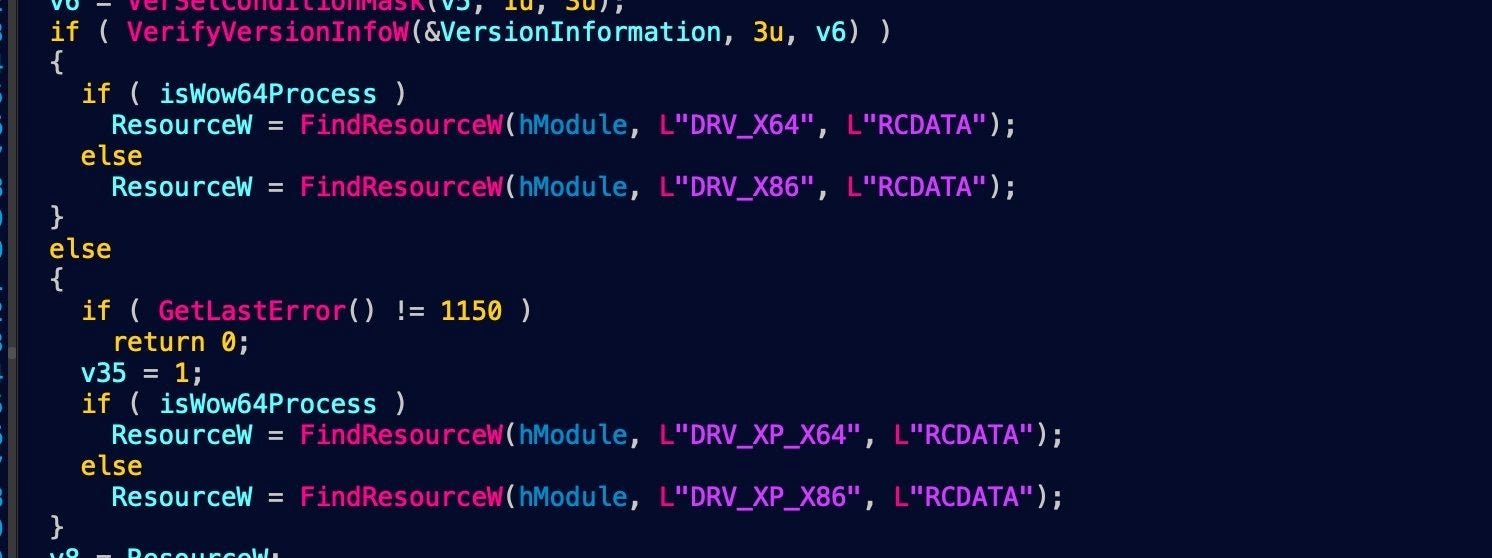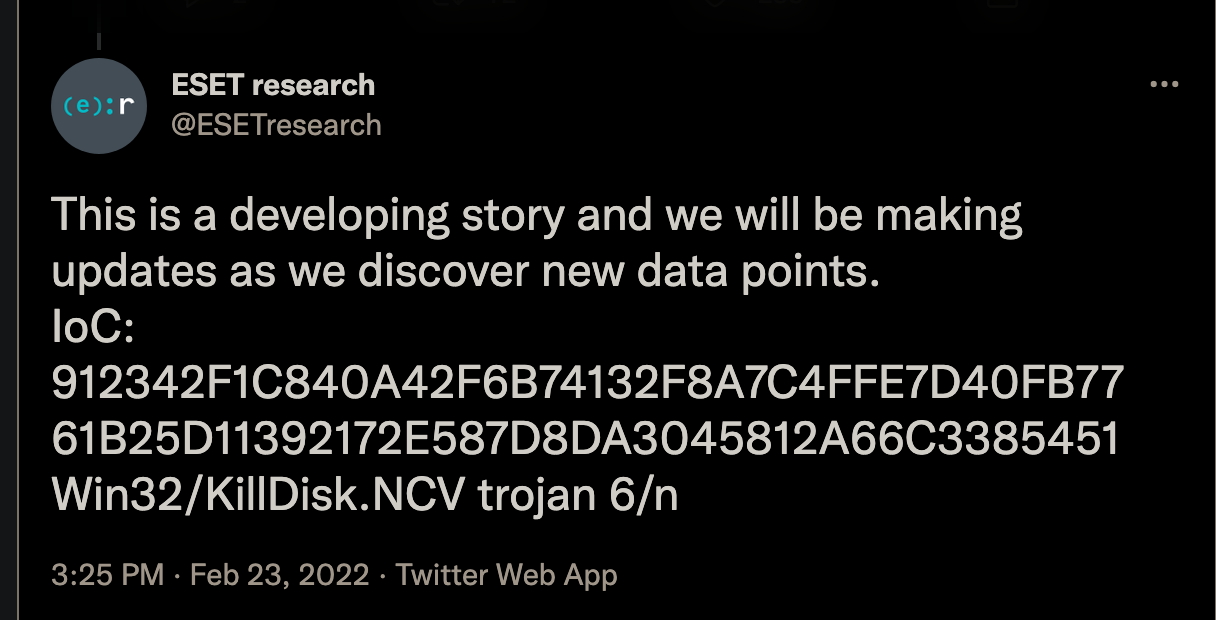This post was updated Feb 28th 2022 to include new IOCs and the PartyTicket ‘decoy ransomware’.
Executive Summary
- On February 23rd, the threat intelligence community began observing a new wiper malware sample circulating in Ukrainian organizations.
- Our analysis shows a signed driver is being used to deploy a wiper that targets Windows devices, manipulating the MBR resulting in subsequent boot failure.
- This blog includes the technical details of the wiper, dubbed HermeticWiper, and includes IOCs to allow organizations to stay protected from this attack.
- This sample is actively being used against Ukrainian organizations, and this blog will be updated as more information becomes available.
- We also analyze a ‘ransomware’, called PartyTicket, reportedly used as a decoy during wiping operations.
- SentinelOne customers are protected from this threat, no action is needed.
Background
On February 23rd, our friends at Symantec and ESET research tweeted hashes associated with a wiper attack in Ukraine, including one which is not publicly available as of this writing.
We started analyzing this new wiper malware, calling it ‘HermeticWiper’ in reference to the digital certificate used to sign the sample. The digital certificate is issued under the company name ‘Hermetica Digital Ltd’ and valid as of April 2021. At this time, we haven’t seen any legitimate files signed with this certificate. It’s possible that the attackers used a shell company or appropriated a defunct company to issue this digital certificate.

This is an early effort to analyze the first available sample of HermeticWiper. We recognize that the situation on the ground in Ukraine is evolving rapidly and hope that we can contribute our small part to the collective analysis effort.
Technical Analysis
At first glance, HermeticWiper appears to be a custom-written application with very few standard functions. The malware sample is 114KBs in size and roughly 70% of that is composed of resources. The developers are using a tried and tested technique of wiper malware, abusing a benign partition management driver, in order to carry out the more damaging components of their attacks. Both the Lazarus Group (Destover) and APT33 (Shamoon) took advantage of Eldos Rawdisk in order to get direct userland access to the filesystem without calling Windows APIs. HermeticWiper uses a similar technique by abusing a different driver, empntdrv.sys.

The copies of the driver are ms-compressed resources. The malware deploys one of these depending on the OS version, bitness, and SysWow64 redirection.

The benign EaseUS driver is abused to do a fair share of the heavy-lifting when it comes to accessing Physical Drives directly as well as getting partition information. This adds to the difficulty of analyzing HermeticWiper, as a lot of functionality is deferred to DeviceIoControl calls with specific IOCTLs.
MBR and Partition Corruption
HermeticWiper enumerates a range of Physical Drives multiple times, from 0-100. For each Physical Drive, the \\.\EPMNTDRV\ device is called for a device number.

The malware then focuses on corrupting the first 512 bytes, the Master Boot Record (MBR) for every Physical Drive. While that should be enough for the device not to boot again, HermeticWiper proceeds to enumerate the partitions for all possible drives.
They then differentiate between FAT and NTFS partitions. In the case of a FAT partition, the malware calls the same ‘bit fiddler’ to corrupt the partition. For NTFS, the HermeticWiper parses the Master File Table before calling this same bit fiddling function again.

We euphemistically refer to the bit fiddling function in the interest of brevity. Looking through it, we see calls to Windows APIs to acquire a cryptographic context provider and generate random bytes. It’s likely this is being used for an inlined crypto implementation and byte overwriting, but the mechanism isn’t entirely clear at this time.
Further functionality refers to interesting MFT fields ($bitmap, $logfile) and NTFS streams ($DATA, $I30, $INDEX_ALLOCATION). The malware also enumerates common folders (‘My Documents’, ‘Desktop’, ‘AppData’), makes references to the registry (‘ntuser’), and Windows Event Logs ("\\\\?\\C:\\Windows\\System32\\winevt\\Logs"). Our analysis is ongoing to determine how this functionality is being used, but it is clear that having already corrupted the MBR and partitions for all drives, the victim system should be inoperable by this point of the execution.
Along the way, HermeticWiper’s more mundane operations provide us with further IOCs to monitor for. These include the momentary creation of the abused driver as well as a system service. It also modifies several registry keys, including setting the SYSTEM\CurrentControlSet\Control\CrashControl CrashDumpEnabled key to 0, effectively disabling crash dumps before the abused driver’s execution starts.

Finally, the malware waits on sleeping threads before initiating a system shutdown, finalizing the malware’s devastating effect.
A Decoy Ransomware – PartyTicket
On February 24th, 2022, Symantec researchers pointed to a new Go ransomware being used as a decoy alongside the deployment of HermeticWiper. During our analysis we decided to name it PartyTicket based on some of the strings used by the malware developers:

The idea of using a ransomware as a decoy for a wiper is counterintuitive. In particular, a ransomware as poorly coded as PartyTicket is more likely to tie up resources during the execution of an otherwise efficient wiper.
As often happens to amateur Go developers, the malware has poor control over its concurrent threads and the commands it attempts to run. This leads to hundreds of threads and events spawned in our consoles. That is to say, it’s a very loud and ineffective ransomware that should fire alerts left and right.
The folder organization and function naming conventions within the binary show the developer’s intent for taunting the U.S. Government and the Biden administration.

Similar taunting can be found in the ransom note after execution:

In trying to understand the execution flow of PartyTicket, we see the 403forBiden.wHiteHousE.primaryElectionProcess() function recursively enumerating folders:

The resulting number of folders will be used as an upperbound for concurrent threads, a mistake by the Go devs as that effectively ties up all of the system’s resources. While the files found are all queued into a channel for the threads to reference.

The function indirectly called for each thread is main.subscribeNewPartyMember(). It in turn takes a filename, makes a copy with a <UUID>.exe name and deletes the original file. Then we expect a second loop to relieve that queue of files and run each through a standard Go AES crypto implementation. However, execution is unlikely to get this far with the current design of PartyTicket.
(Thanks to Joakim Kennedy (Intezer) for pointing out this indirect call)

Overall our analysis of PartyTicket indicates it to be a rather simple, poorly coded, and loud malware. Its possible role as a decoy ransomware deployed alongside HermeticWiper is more likely to be effective for its accidental hogging of the victim organization’s system resources rather than the encryption of files itself. IOCs and Yara rules have been added below.
Conclusion
After a week of defacements and increasing DDoS attacks, the proliferation of sabotage operations through wiper malware is an expected and regrettable escalation. At this time, we have a very small sliver of aperture into the attacks in Ukraine and subsequent spillover into neighboring countries and allies. If there’s a silver lining to such a difficult situation, it’s seeing the open collaboration between threat intel research teams, independent researchers, and journalists looking to get the story straight. Our thanks to the researchers at Symantec, ESET, Stairwell, and RedCanary among others who’ve contributed samples, time, and expertise.
SentinelOne Customers Protected
Indicators of Compromise
(Updated February 28th, 2022)
| ms-compressed resources | SHA1 |
| RCDATA_DRV_X64 | 5ceebaf1cbb0c10b95f7edd458804a646c6f215e |
| RCDATA_DRV_X86 | 0231721ef4e4519ec776ff7d1f25c937545ce9f4 |
| RCDATA_DRV_XP_X64 | 9c2e465e8dfdfc1c0c472e0a34a7614d796294af |
| RCDATA_DRV_XP_X86 | ee764632adedf6bb4cf4075a20b4f6a79b8f94c0 |
| HermeticWiper | SHA1 |
| Win32 EXE | 0d8cc992f279ec45e8b8dfd05a700ff1f0437f29 |
| Win32 EXE | 61b25d11392172e587d8da3045812a66c3385451 |
| Win32 EXE | 912342f1c840a42f6b74132f8a7c4ffe7d40fb77 |
| Win32 EXE | 9518e4ae0862ae871cf9fb634b50b07c66a2c379 |
| Win32 EXE | d9a3596af0463797df4ff25b7999184946e3bfa2 |
| PartyTicket | SHA-1 |
| Win32 EXE | f32d791ec9e6385a91b45942c230f52aff1626df |
YARA Rules
(https://github.com/SentineLabs/Yara/blob/main/APT_RU_SunFlowerSeed.yar)
import "pe"
rule MAL_HERMETIC_WIPER {
meta:
desc = "Hermetic Wiper - broad hunting rule"
author = "Hegel @ SentinelLabs"
version = "1.0"
last_modified = "02.23.2022"
hash = "1bc44eef75779e3ca1eefb8ff5a64807dbc942b1e4a2672d77b9f6928d292591"
reference = "https://www.sentinelone.com/labs/hermetic-wiper-ukraine-under-attack/"
strings:
$string1 = "DRV_XP_X64" wide ascii nocase
$string2 = "EPMNTDRV\\%u" wide ascii nocase
$string3 = "PhysicalDrive%u" wide ascii nocase
$cert1 = "Hermetica Digital Ltd" wide ascii nocase
condition:
uint16(0) == 0x5A4D and
all of them
}
rule MAL_PARTY_TICKET {
meta:
desc = "PartyTicket / HermeticRansom Golang Ransomware - associated with HermeticWiper campaign"
author = "Hegel @ SentinelLabs"
version = "1.0"
last_modified = "02.24.2022"
hash = "4dc13bb83a16d4ff9865a51b3e4d24112327c526c1392e14d56f20d6f4eaf382"
reference = "https://twitter.com/juanandres_gs/status/1496930731351805953"
strings:
$string1 = "/403forBiden/" wide ascii nocase
$string2 = "/wHiteHousE/" wide ascii
$string3 = "vote_result." wide ascii
$string4 = "partyTicket." wide ascii
$buildid1 = "Go build ID: \"qb0H7AdWAYDzfMA1J80B/nJ9FF8fupJl4qnE4WvA5/PWkwEJfKUrRbYN59_Jba/2o0VIyvqINFbLsDsFyL2\"" wide ascii
$project1 = "C:/projects/403forBiden/wHiteHousE/" wide ascii
condition:
uint16(0) == 0x5A4D and
(2 of ($string*) or
any of ($buildid*) or
any of ($project*))
}
rule MAL_COMPROMISED_HERMETICA_CERT {
meta:
desc = "Hermetica Cert - broad hunting rule based on the certificate used in HermeticWiper and HermeticWizard"
author = "Hegel @ SentinelLabs"
version = "1.0"
last_modified = "03.01.2022"
hash = "1bc44eef75779e3ca1eefb8ff5a64807dbc942b1e4a2672d77b9f6928d292591"
reference = "https://www.sentinelone.com/labs/hermetic-wiper-ukraine-under-attack/"
condition:
uint16(0) == 0x5a4d and
for any i in (0 .. pe.number_of_signatures) : (
pe.signatures[i].issuer contains "DigiCert EV Code Signing CA" and
pe.signatures[i].serial == "0c:48:73:28:73:ac:8c:ce:ba:f8:f0:e1:e8:32:9c:ec"
)
}
rule MAL_ISSAC_WIPER {
meta:
desc = "Issac Wiper - broad hunting rule"
author = "Hegel @ SentinelLabs"
version = "1.0"
last_modified = "03.01.2022"
hash = "13037b749aa4b1eda538fda26d6ac41c8f7b1d02d83f47b0d187dd645154e033"
reference = "https://www.welivesecurity.com/2022/03/01/isaacwiper-hermeticwizard-wiper-worm-targeting-ukraine/"
strings:
$name1 = "Cleaner.dll" wide ascii
$name2 = "cl.exe" wide ascii nocase
$name3 = "cl64.dll" wide ascii nocase
$name4 = "cld.dll" wide ascii nocase
$name5 = "cll.dll" wide ascii nocase
$name6 = "Cleaner.exe" wide ascii
$export = "_Start@4" wide ascii
condition:
uint16(0) == 0x5A4D and
(any of ($name*) and $export)
}
rule MAL_HERMETIC_WIZARD {
meta:
desc = "HermeticWizard hunting rule"
author = "Hegel @ SentinelLabs"
version = "1.0"
last_modified = "03.01.2022"
reference = "https://www.welivesecurity.com/2022/03/01/isaacwiper-hermeticwizard-wiper-worm-targeting-ukraine/"
strings:
$name1 = "Wizard.dll" wide ascii
$name2 = "romance.dll" wide ascii
$name3 = "exec_32.dll" wide ascii
$function1 = "DNSGetCacheDataTable" wide ascii
$function2 = "GetIpNetTable" wide ascii
$function3 = "WNetOpenEnumW" wide ascii
$function4 = "NetServerEnum" wide ascii
$function5 = "GetTcpTable" wide ascii
$function6 = "GetAdaptersAddresses" wide ascii
$function7 = "GetEnvironmentStrings" wide ascii
$ip_anchor1 = "192.168.255.255" wide ascii
condition:
uint16(0) == 0x5A4D and
(any of ($function*) and any of ($name*) and $ip_anchor1)
}
SentinelOne STAR Rules
EventType = "Process Creation" AND TgtProcPublisher = "HERMETICA DIGITAL LTD" AND ( SrcProcSignedStatus = "signed" AND IndicatorPersistenceCount = "2" AND RegistryValue = "4" AND RegistryKeyPath = "MACHINE\SYSTEM\ControlSet001\Services\VSS\Start" ) AND SrcProcImagePath !~ "devsetup64.exe"





